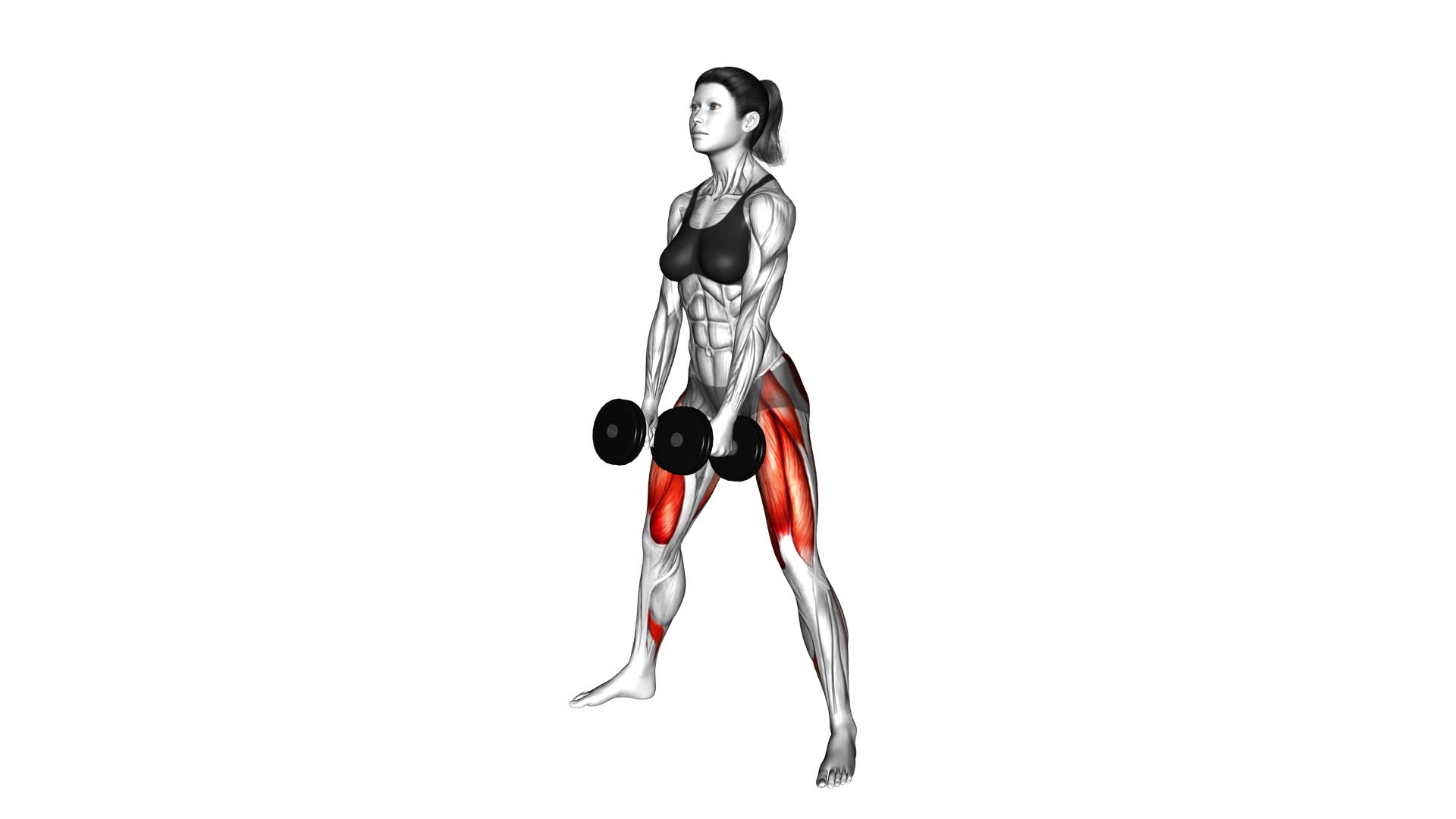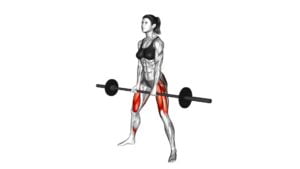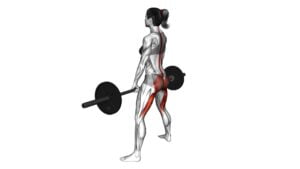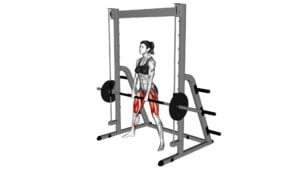Dumbbell Sumo Deadlift (female) – Video Exercise Guide & Tips

Get ready to strengthen your glutes and hamstrings with the dumbbell sumo deadlift!
Watch This Exercise Video
In this video exercise guide, we'll show you the proper form and set-up, as well as provide tips for choosing the right dumbbell weight.
Follow our step-by-step execution to ensure you're performing this exercise correctly and avoiding common mistakes.
Plus, we'll share tips for maximizing glute and hamstring engagement and offer modifications and variations for different fitness levels.
Let's get started!
Key Takeaways
- Proper form and set-up are crucial for performing the dumbbell sumo deadlift effectively.
- Choosing the right dumbbell weight is important for progression and avoiding injury.
- The step-by-step execution involves standing with feet wider than shoulder-width apart, bending knees and hinging at the hips, and using an overhand grip to lift the dumbbells off the ground.
- Maximizing glute and hamstring engagement can be achieved by driving through the heels, activating lower body muscles, focusing on form and technique, and adjusting as needed based on how your body feels.
Proper Form and Set-Up
To properly execute the dumbbell sumo deadlift, begin by positioning yourself with your feet shoulder-width apart and the dumbbells placed on the ground in front of you. This exercise is a variation of the traditional deadlift, focusing on the lower body, specifically the glutes, hamstrings, and quadriceps.
To set up correctly, make sure your feet are turned out at a slight angle, wider than your shoulders. This wider stance targets the inner thigh muscles more effectively. Grab the dumbbells with an overhand grip and lower your hips, keeping your back straight and chest up. Engage your core and maintain a neutral spine throughout the movement.
As you begin the lift, drive through your heels and push your hips forward, extending your knees and hips simultaneously. Keep your arms straight and maintain control as you stand up tall. To avoid putting excessive strain on your lower back, make sure to keep it neutral and avoid rounding.
Some common cues to remember during the dumbbell sumo deadlift are to push through your heels, squeeze your glutes at the top of the movement, and maintain a strong core throughout.
The benefits of the dumbbell sumo deadlift include strengthening the lower body muscles, improving hip mobility, and enhancing overall functional fitness.
Choosing the Right Dumbbell Weight
To choose the right dumbbell weight for the dumbbell sumo deadlift, assess your current strength level and select a weight that challenges you without sacrificing proper form. Here are some tips to help you make the right choice:
- Start with a weight that you can comfortably lift for 8-12 repetitions. This weight should challenge you but still allow you to maintain good form throughout the exercise.
- Gradually increase the weight as you become stronger. Aim to increase the weight by 5-10% once you can easily complete 12 repetitions with the current weight.
- Pay attention to how your body feels during the exercise. If the weight feels too light and you can easily complete the desired number of repetitions, it's time to increase the weight.
- On the other hand, if the weight feels too heavy and you struggle to maintain proper form, it's a sign that you should decrease the weight.
Choosing the right dumbbell weight is crucial for maximizing the benefits of the dumbbell sumo deadlift for overall strength. By selecting a weight that challenges you, you'll effectively target your glutes, hamstrings, quads, and back muscles.
Incorporating the dumbbell sumo deadlift into a full body workout routine can help improve your overall strength, increase muscle mass, and enhance your athletic performance. Remember, always prioritize proper form and listen to your body when selecting the appropriate dumbbell weight.
Step-By-Step Execution of the Dumbbell Sumo Deadlift
To execute the dumbbell sumo deadlift, grab a pair of dumbbells that challenge your strength and place them on the ground in front of you. Stand with your feet wider than shoulder-width apart, toes pointed out at a 45-degree angle. Bend your knees and hinge at the hips, keeping your back straight and chest lifted.
Grab the dumbbells with an overhand grip, palms facing your body. Engage your core and push through your heels as you lift the dumbbells off the ground, extending your hips and knees until you're standing upright. Keep your shoulders pulled back and down, and squeeze your glutes at the top of the movement. Lower the dumbbells back down to the ground, maintaining control throughout the exercise.
The dumbbell sumo deadlift offers several benefits, including targeting the glutes, hamstrings, and quadriceps. It also improves grip strength and overall lower body strength. Additionally, this exercise can be modified to suit your fitness level. If you're a beginner, you can start with lighter dumbbells or perform the movement without weights until you build up strength. On the other hand, if you're more advanced, you can increase the weight of the dumbbells or try single-leg variations to challenge yourself further.
Now that you know how to properly perform the dumbbell sumo deadlift, let's move on to the next section to learn about common mistakes to avoid.
Common Mistakes to Avoid
Avoid these common mistakes when performing the dumbbell sumo deadlift to maximize the effectiveness of the exercise and prevent injury. Here are some key errors to watch out for:
- Rounding your back: Maintaining proper form is crucial during the dumbbell sumo deadlift. Avoid rounding your back, as this can strain your spine and lead to injury. Keep your back flat and engage your core throughout the movement.
- Using too much weight: It's important to choose an appropriate weight that allows you to perform the exercise with proper technique. Using weights that are too heavy can compromise your form and increase the risk of injury. Start with lighter weights and gradually increase as you become more comfortable.
- Neglecting proper foot positioning: To execute the dumbbell sumo deadlift correctly, your feet should be wider than shoulder-width apart and turned out slightly. Neglecting proper foot positioning can limit your range of motion and decrease the effectiveness of the exercise.
- Lifting the weights with your arms: The dumbbell sumo deadlift primarily targets the lower body, particularly the glutes and hamstrings. Avoid relying on your arms to lift the weights. Instead, focus on driving through your heels and using the power of your legs and hips to lift the weights.
By avoiding these common mistakes and practicing proper technique, you can ensure that you're getting the most out of your dumbbell sumo deadlifts.
Now, let's move on to some tips for maximizing glute and hamstring engagement.
Tips for Maximizing Glute and Hamstring Engagement
To maximize glute and hamstring engagement during the dumbbell sumo deadlift, focus on driving through your heels and activating your lower body muscles. By doing so, you'll maximize muscle activation in these areas and enhance the effectiveness of this exercise in targeting your glutes and hamstrings. The dumbbell sumo deadlift is a great exercise to incorporate into a full body workout, as it not only targets your lower body muscles but also engages your core, back, and arms.
To ensure maximum engagement of your glutes and hamstrings, start by standing with your feet wider than shoulder-width apart and toes pointed slightly outwards. As you lower the dumbbells towards the ground, make sure to push your hips back and keep your chest up. As you lift the dumbbells back up, focus on driving through your heels and squeezing your glutes at the top of the movement.
Incorporating the dumbbell sumo deadlift into your full body workout can help you build strength and increase muscle activation in your glutes and hamstrings. By including exercises that target different muscle groups, you can create a well-rounded workout routine that promotes overall strength and stability.
Transitioning into the next section about modifications and variations for different fitness levels, it's important to note that the dumbbell sumo deadlift can be modified to suit individual needs and abilities.
Modifications and Variations for Different Fitness Levels
Choose appropriate modifications and variations for your fitness level to customize the dumbbell sumo deadlift exercise. By making adjustments based on your abilities and goals, you can ensure a safe and effective workout. Here are some progression options and injury prevention strategies to consider:
- Adjust the weight: If you're new to the exercise or have limited strength, start with lighter dumbbells and gradually increase the weight as you become more comfortable and confident. This will help prevent strain or injury.
- Modify the stance: If you find the wide sumo stance challenging, try a narrower stance to make the exercise more manageable. As you build strength and flexibility, you can gradually widen your stance for increased difficulty and engagement of different muscle groups.
- Use a resistance band: Incorporating a resistance band can provide additional resistance and challenge for the muscles involved in the sumo deadlift. Wrap the band around your knees or ankles to add tension and increase the intensity of the exercise.
- Add a plyometric element: For advanced fitness levels, you can incorporate a jump or explosive movement into the sumo deadlift. This plyometric variation increases power and can help improve athletic performance.
Remember to always prioritize proper form and technique over the difficulty level of the exercise. Listen to your body and make adjustments accordingly to prevent injuries and ensure a successful workout.
Frequently Asked Questions
Are Dumbbell Sumo Deadlifts Suitable for Beginners?
Dumbbell sumo deadlifts can be suitable for beginners. They offer a range of benefits, such as targeting multiple muscle groups, including the glutes, hamstrings, and quadriceps.
However, it's important to be aware of common mistakes. These can include rounding your back, not engaging your core, or lifting too heavy of a weight.
Can I Perform Dumbbell Sumo Deadlifts if I Have Lower Back Pain?
When you have lower back pain, it's important to consider modifications before performing dumbbell sumo deadlifts. Doing this exercise with lower back pain can potentially exacerbate your condition and cause further discomfort.
It's recommended to consult with a healthcare professional or a certified trainer who can provide you with appropriate modifications or alternative exercises that are more suitable for your condition.
Your safety and well-being should always be the top priority when it comes to exercise.
How Many Reps and Sets Should I Do for Dumbbell Sumo Deadlifts?
For the dumbbell sumo deadlift exercise, the number of reps and sets you should do depends on your fitness goals and current strength level.
It's recommended to start with 3-4 sets of 8-12 reps, using a weight that challenges you but still allows proper form.
As you progress, you can increase the weight and decrease the reps for more strength-building.
Is It Necessary to Warm up Before Doing Dumbbell Sumo Deadlifts?
Before performing dumbbell sumo deadlifts, it's necessary to warm up to prevent injury and enhance performance. Incorporating dynamic stretches before your workout can help increase blood flow to the muscles, improve flexibility, and prepare your body for the exercise.
It's also important to be aware of common mistakes to avoid while performing this exercise, such as rounding your back or lifting with improper form. Practicing proper technique will help you maximize the benefits of this exercise.
Can I Replace Dumbbell Sumo Deadlifts With Barbell Sumo Deadlifts for Better Results?
Yes, you can definitely replace dumbbell sumo deadlifts with barbell sumo deadlifts for better results.
Incorporating both dumbbell and barbell sumo deadlifts into your workout routine offers a variety of benefits.
It helps to improve overall strength, targets different muscle groups, and enhances your grip strength.
Additionally, by using different variations and modifications of sumo deadlifts, you can cater to different fitness levels and goals.
Conclusion
In conclusion, the dumbbell sumo deadlift is an effective exercise for targeting the glutes and hamstrings.
By following proper form and choosing the right dumbbell weight, you can maximize the engagement of these muscle groups.
It's important to avoid common mistakes and consider modifications or variations to suit different fitness levels.
Incorporating this exercise into your workout routine will help you achieve stronger and more toned lower body muscles.

Author
Years ago, the spark of my life’s passion ignited in my mind the moment I stepped into the local gym for the first time. The inaugural bead of perspiration, the initial endeavor, the very first surge of endorphins, and a sense of pride that washed over me post-workout marked the beginning of my deep-seated interest in strength sports, fitness, and sports nutrition. This very curiosity blossomed rapidly into a profound fascination, propelling me to earn a Master’s degree in Physical Education from the Academy of Physical Education in Krakow, followed by a Sports Manager diploma from the Jagiellonian University. My journey of growth led me to gain more specialized qualifications, such as being a certified personal trainer with a focus on sports dietetics, a lifeguard, and an instructor for wellness and corrective gymnastics. Theoretical knowledge paired seamlessly with practical experience, reinforcing my belief that the transformation of individuals under my guidance was also a reflection of my personal growth. This belief holds true even today. Each day, I strive to push the boundaries and explore new realms. These realms gently elevate me to greater heights. The unique combination of passion for my field and the continuous quest for growth fuels my drive to break new ground.







